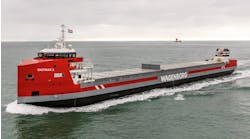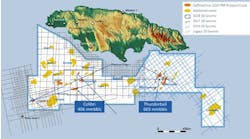(Left) hughes' emergency safety shower in action.(Right) Westmark's safety hook.
OPITO training course
Britain's Offshore Petroleum Industry Training Board (OPITO) has ompleted its joint industry review of the Basic Offshore Safety Induction and Emergency Training standards.
The new training programme cuts the traditional four-day course by two days. OPITO claims this will lead to a more focussed approach to basic offshore training, but there has also been pressure from oil companies to curb mounting safety costs under the UK's CRINE initiative.
All key elements of offshore survival training have been retained, but the revised programme is more practical, with less emphasis on theory. Also, numbers of trainees on each course have been cut from 24 to 16.
The review of these standards is the first since 1986, and involved co-operation of UKOOA, the IADC, the HSE, the Offshore Contractors' Council and the Inter Union Offshore Oil Committee.
UKOOA has also worked with the Standby Ship Operators' Association to produce new guidelines for `Standby Vessel Performance Standards'. These set out improved safety standards, not just to the vessel operators but also the owners of offshore installations they work for. Copies of the guidelines are available from UKOOA at 3 Hans Crescent, London SW1X OLN, Tel: (44) 171-5895255, price $10.
Emergency showers
Stockport, UK-based Hughes Safety Showers has launched a new range of general purpose, unheated emergency safety showers and eyebath/facewash models. The range extends from simple wall-mounted units to free-standing models complete with body spray and eyewash/facewash fountains.
Auto 2003 lifejacket for Tartan
Texaco has chosen Dunlop-Beaufort's Auto 2003 lifejacket for use on its Tartan platform. This followed rigorous tests on the jacket at the RGIT centre in Dundee.
Auto 2003 has two chambers, each inflated by its own CO2 cylinder which activates automatically on contact with water, or manually through a single pull on the beaded operating handle. The lifejackets incorporate a flame-retardant pouch and a ventilated sprayhood accommodated in a rear neck pack.
Merseyside Fire Brigade have opted for Dunlop-Beaufort's Transafe 2000 series lifejackets for use in offshore firefighting operations. Merseyside's helicopter crews will use the 2002 Aviation lifejacket, with seaborne firefighters wearing the Automatic 2003. Advantages cited during tests were the jackets' high buoyancy, which made them capable of supporting firefighters at the correct flotation angle when wearing breathing apparatus.
AEA tests Conoco's riser pipes
Conoco Norway has commissioned AEA Technology to test the safety of its platforms' riser pipes. Conoco was concerned that these might be vulnerbale to fires on the seabed. Using facilities designed for nuclear industry safety tests, AEA set up poll fires and measured the temperature of the risers as a function of time. As a result, Conoco has been able to verify that the risers were safe, and so did not need costly, extra-protective fire coatings.
Mobil study into explosion risks
Over the past few years, Mobil North Sea has instigated a programme of R&D into probabilistic modelling of explosion risks on topsides structures. This work has also covered modelling of the mitigation effect of deluge systems. Mobil and other major operators are now also backing a new three-year study which will look at the application of probabilistic methodologies for cost-effective management of explosion risks. The study group aim to develop a fully rational decision support tool which also provides the most cost-effective design solution possible based on expected utility, and ensures that the design is ALARP from the point of view of risk to personnel.
Hook avoids damage
During repair and maintenance operations, cables and cords must be suspended away from the workfloor. Usually tape, pieces of rope or bent iron bars are used, but these can cause dangerous situations and in some cases damage the cable or hose. Since the middle of last year, several operators in the Dutch offshore sector, including NAM, Unocal, Lasmo and Clyde, have used an alternative system called the Safety Hook, supplied by Westmark of Amersfoort in The Netherlands. This is a simple `S' shaped multifunctional hook made of a non-conductive inflammable thermoplastic which can be reused. The hooks come in three sizes for different loads, and have been tested and approved by DnV.
Handheld floodlight
Wolf Safety, Sheffield, UK has introduced a rechargeable hand-held floodlight, the Toplite TL 9055, with a 35W halogen bulb which produces a trapezoidal flood for up to 100 minutes on full power. It is designed for undertaking short duration tasks in potentially explosive conditions, The unit's 1,600 candlepower through its 60/90 included angle of illumination makes it a far more convenient light source than alternatives such as flameproof lead or compressed air-operated turbo alternator lamps, Wolf claims.
Cost-cutting Gard 1000
Gard 1000 is a compact, process control system which eliminates the need to install pressurised local equipment rooms to create safe areas for barrier systems. It also brings savings by reducing the number of instrument cable runs. For instance, a wellhead control system on a North Sea platform saved the operator 13.5km of multicore cable weighing 27.9 tonnes, cutting $1.5 million off installation costs. Gard 1000 was developed in Norway and is available in the UK from Gard Controls, Sissinghurst.
Copyright 1995 Offshore. All Rights Reserved.



